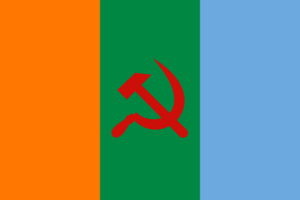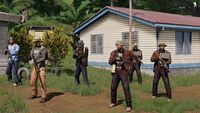United Revolutionary Forces of Faramount
| United Revolutionary Forces of Faramount | |
|---|---|
| Faramontese Forze Rivoluzionarie Unite; FFRU (Limonaian) | |
 Flag of the People's Republic of Faramount | |
| Founded | 1902 |
| Current form | 1963 |
| Leadership | |
| Prime Minister | Sofia Savio |
| Minister of Defense | Letterio Tolerico |
| General | Giadero Sforza |
| Personnel | |
| Military age | 16-65 |
| Conscription | Yes |
| Active personnel | 3,000-5,000 |
| Expenditure | |
| Budget | $30 million (2017) |
| Industry | |
| Foreign suppliers | Fulgistan |
| Annual imports | $10 million (2017) |
The United Revolutionary Forces of Faramount (Limonaian: Faramontese Forze Rivoluzionarie Unite; FFRU) are the armed forces of the People's Republic of Faramount. The FFRU is most noteworthy for its activities as an armed resistance group in Faramount, where since 1963 its followers have fought to reverse the military coup d'état that overthrew the democratic government of the Republic of Faramount. But the FFRU also has a small wing in Fulgistan, protecting the offices and other buildings of the RPF, and carrying out supply missions for resistance fighters in Faramount. The United Revolutionary Forces had a budget of approximately $30 million in 2017, most of which was used to compensate the FFRU's 3,000-5,000 resistance fighters, several hundred active-duty conscripts in Fulgistan, and few dozen reservists in Fulgistan.
History
The Socialist Party upset the Republic of Faramount's longstanding power structures when it won control of parliament in 1952, and the socialist leaders recognized the likelihood of those power structures striking back. Specifically, socialist leaders recognized that the Fara-dominated army and police force, and the Limonaian dominated oil companies, might very well depose the government to reverse the socialists' programs. To defend against this, the socialist sought in the 1950s to undermine the strength of the army and national police, cutting their funding while substantially expanding the navy, air force, and local and special law enforcement agencies. The socialists had by the 1960s solidified themselves substantially, and they hoped within a decade to disband the army altogether.
The Limonaian-backed military coup d'état on 12 July 1963 destroyed the socialists' plans. As the socialists had hoped, the navy, air force, and local and special police agencies fought to protect the republic, siding with Faramount's elected government against the army. But ultimately, despite the socialists' heavy investment in these groups, the army ultimately prevailed. After twelve hours of heavy fighting in New Limone, republican forces abandoned parliament, and organized a hasty retreat. While city police provided cover, naval, air, and political personnel fled, requisitioning every available ship in New Limone's harbor. Most of the navy itself was unable to escape, but the Tigre led the flotilla of evacuation vessels away from the capital in the early afternoon of 12 July.
Most supporters of the regime lived in the Faramontese countryside, however, and it is here that local police, scattered air and naval units, and other loyalists started the FFRU's longstanding guerrilla war against the Democratic Republic of Faramount. Within weeks, these forces had abandoned all pretense of pre-war organization, instead fighting together in ad hoc units against the Faramontese Army. As the People's Republic of Faramount established itself, it recognized this change, and in late 1963, reorganized all resistance fighters under the banner of the United Revolutionary Forces of Faramount. The Revolutionary Congress created the Joint Revolutionary Task force around the same time, committing the escaped military personnel in Fulgistan to the mission of supplying the insurgency. The FFRU at that point controlled large swaths of rural Faramount, and with the assistance of Fulgistani munitions and funds, RPF leaders genuinely hoped to effect a counterrevolution.
The Faramontese Army dashed the hopes of the People's Republic, however, scoring a series of victories against the FFRU in the 1960s. The military junta sped its advance in the 1970s, implementing the widespread use of helicopters to facilitate its operations. The Democratic Republic controlled all but Eastern Faramount by 1975, and by 1980, had seized even much of this Tchebo-dominated bastion of socialist support. The FFRU gained an advantage in the 1980s with the use of Fulgistani-provided MANPADs, but this only slowed the tide, particularly once the Faramontese Army begun relying more upon mechanized infantry in response. Yet even as it faced consistent setbacks militarily, the FFRU retained the strong support of the Tchebo people, due to the values instilled in FFRU fighters by the Fulgistani-drafted FFRU Doctrinal Handbook. Colloquially known as the "FFRU bible," the handbook urged the respectful treatment of civilians and prisoners, an attitude that consistently gained the FFRU goodwill. With the democratization of Fulgistan (and, by proxy, the People's Republic), the FFRU's popularity only grew, as Tchebo people actually saw FFRU personnel and supporters voting to elect their leaders.
The United Revolutionary Forces today remain an active, effective fighting force, even after fifty-five years of struggle. The FFRU focuses entirely upon insurgency tactics, using hit-and-run tactics to demoralize and devastate government forces. The Faramontese Armed Forces possess the ability to win any fight with with the FFRU, but the small size of the military means that it is limited to only major offensive operations. Once the armed forces have secured an area, they must necessarily move on, turning over responsibility for counter-insurgency operations to the corrupt and incompetent Faramontese Security Forces. The FFRU has consistently been able to rout these personnel, despite the efforts of the Terrone Regime's Ministry of Justice to make the Paramilitary Police into an effective fighting force. An effective stalemate thus exists in Eastern Faramount -- any time the government advances, it is subsequently pushed back, but the FFRU itself cannot afford a major offensive operation.
Organization
The Prime Minister of the People's Republic of Faramount serves as the official commander-in-chief of the FFRU, subject to extensive oversight by the Revolutionary Congress. The Ministry of Defense ostensibly oversees the administration of the armed forces under a strict doctrine of civilian control of the military. Yet in reality, the prime minister's authority is severely limited, and the ministry has only several dozen employees.. The vast majority of FFRU personnel are guerrilla warriors dispersed across thousands of kilometers of jungle halfway across Alharu, and thus unable to receive effective commands or administration from Fulgistan. The senior-most officer of the FFRU, General Giadero Sforza, exercises actual control of these resistance fighters. Most other FFRU service members are Faramontese Fulgistani conscripts effectively placed under Fulgistani control and administration. Only a few dozen personnel truly operate under the intended design of the military of the People's Republic.
The Revolutionary Action Force is by far the largest component of the United Revolutionary Forces, and has responsibility for conducting the war of liberation in Faramount. This force uses guerrilla tactics to wage war against the Terrone regime, whose military superiority is undercut by the corruption and incompetence of its civilian security forces. The RAF organizes its troops into self-sufficient companies, whose leaders operate almost entirely independently of any higher command and control. The general only provides high-level strategic direction to these companies. The specific size of different companies varies generally from as little as 50 to as many as 200 men, particularly depending on season. The FFRU has 3,000-5,000 fighters, but many of these are seasonal warriors, who return home to farm during the agricultural season, then return to fight during the off-season. Indeed, the specific composition of the force regularly changes, as fighters come and go. A great deal of flexibility is necessarily given to company commanders in organization and operations as such.
The other three components of the United Revolutionary Forces are substantially smaller. The Joint Revolutionary Logistics Force is a combined Fulgistani-Faramontese special forces transport unit responsible for smuggling weapons, munitions, and funds into Eastern Faramount to support the FFRU's activities. Fulgistani intelligence operatives lead the approximately 300-person JRLD, which in effect operates almost entirely independently of the People's Republic. The JRLD has no standardized internal organization as its operations require a wide range of activities to get materiel from Fulgistan to Faramount. The Revolutionary Security Force is a unit comprised of approximately fifty Faramontese Fulgistanis who provide security for the RPF Diplomatic and Government Compound in Fulgistan and for the leaders of the People's Republic. The Revolutionary Naval Force is a group of a dozen personnel that operate the Tigre, and more importantly, the educational and training programs that occur aboard and around her.
Personnel
| Rank | Title | Insignia |
|---|---|---|
| One Star | General | One Red Star |
| Field Officer | Colonel | Three Red Stripes |
| Field Officer | Captain | Two Red Stripes |
| Junior Officer | Lieutenant | One Red Stripe |
| Senior NCO | Chief Revolutionary | Three Red Chevrons |
| Junior NCO | Subchief Revolutionary | Two Red Chevrons |
| Enlisted Rank | Revolutionary | Single Red Chevron |
The United Revolutionary Forces of Faramount are comprised of around 3,000-5,000 personnel, though the exact number varies substantially. These personnel are divided principally into two groups: Tchebo people in Eastern Faramount and Faramontese Fulgistanis. The FFRU recruits Faramontese of all ages in the Tchebo-dominated Eastern region of Faramount to fight for its cause, and some 3,000-5,000 are doing so at any time, though many warriors fight only on a seasonal basis or on an irregular basis. There is no formal military training for these personnel, who all enter at enlisted rank, rising to become officers based on merit. The FFRU also recruits Faramontese Fulgistanis of conscription age into its ranks, offering an alternative to mandatory service in the Fulgistani military. These personnel go through Fulgistani military training. A small number of these recruits do travel to Faramount to fight; they are guaranteed an officer's rank, plus substantial compensation.
The FFRU has a single, simplistic rank structure largely designed to facilitate organization of the guerrilla forces in Faramount. Promotions are based solely upon merit with no limitations or requirements for time in service. There is only one enlisted rank, "revolutionary". Nearly two-thirds of FFRU personnel hold this rank, which usually carries no leadership responsibilities, though some senior revolutionaries will command fire teams. A subchief revolutionary is a junior non-commissioned officer responsible for commanding a squad or section. Over a quarter of FFRU personnel hold the rank of Subchief Revolutionary. A chief revolutionary is a senior non-commission officer usually charged with commanding a section or serving as executive officer for a platoon. A lieutenant is a junior officer charged with commanding a platoon. A captain is a field officer responsible for commanding a company. A colonel is a senior officer usually responsible for administrative activities. The general is the senior-most uniformed FFRU officer, regarded as being effectively a one-star rank officer.
The general reputation of the FFRU varies depending on location. In Faramount, it is viewed as a particularly meritocratic, transparent, and corruption-free institution. Many in Eastern Faramount see it as one of few reliable employers. In Fulgistan, the FFRU is largely viewed as a bastion of incompetence, due to the commonality of less capable Fulgistani Faramontese joining the FFRU to avoid service in the Fulgistani Army. To be sure, there are Faramontese Fulgistani FFRU members that have earned the respect of their Fulgistani allies, but these are few and far between.
Equipment
The United Revolutionary Forces lack any air, sea, or armored units of which to speak, instead relying entirely upon small arms, non-standard tactical vehicles, and a variety of civilian cars, boats, and trucks. Fulgistan provides the entirety of the Faramontese arsenal, excepting those items stolen from enemy troops. Fulgistan has mostly passed on equipment slotted for retirement to the Faramontese, though it also from time to time buys older foreign equipment, particularly from Varinco, to supply the Faramontese.
